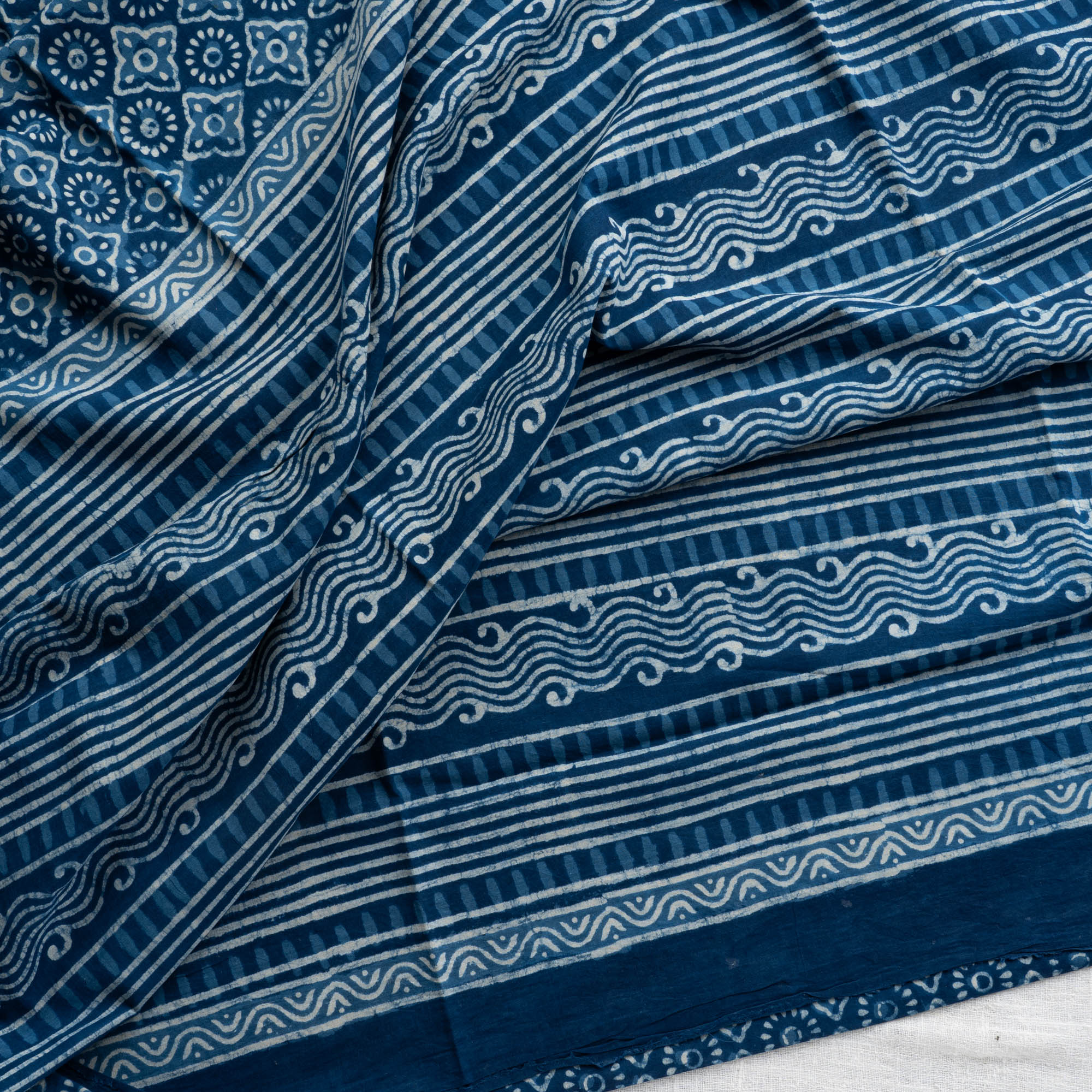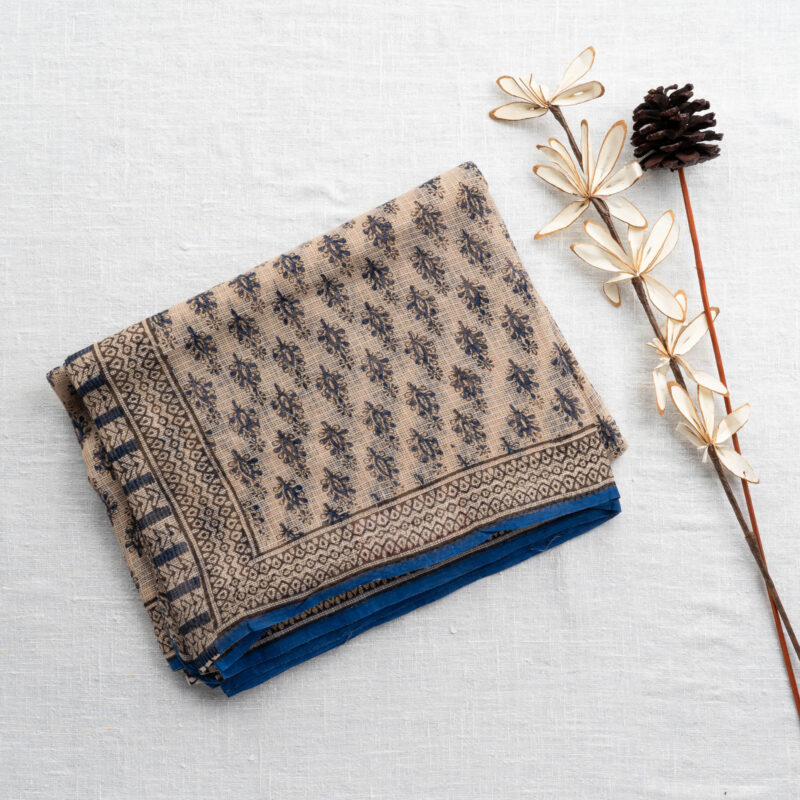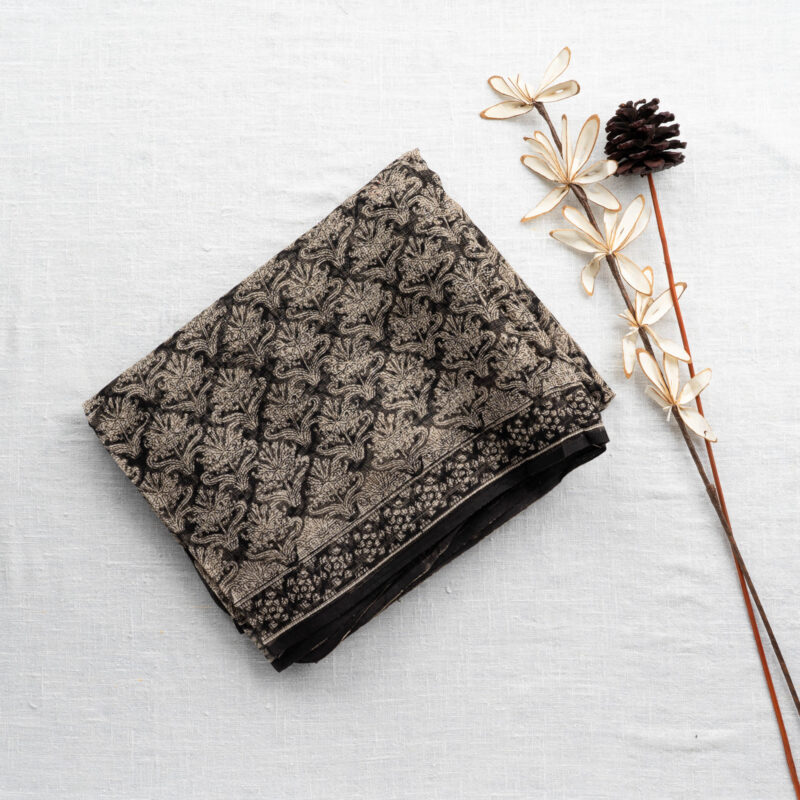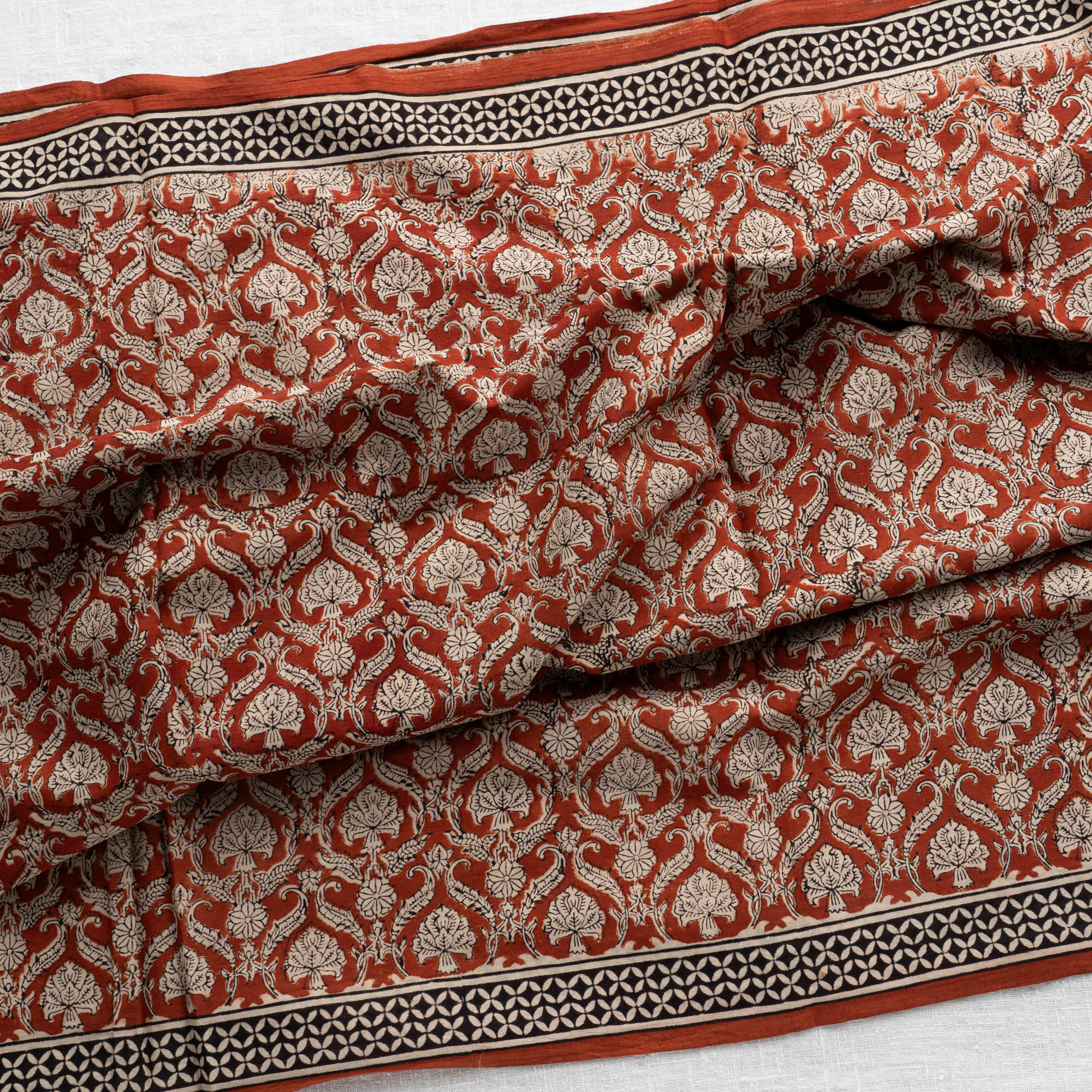Organic Hand Block Print Saree

Wood Block Printing Process
Beautiful Organic Hand Block Print method is a method to print your own designs. Block Printing allows you to customize commercially available fabric.
STEP 1: PREPARING WOOD BLOCKS. The process starts by cutting out wooden pieces with a height of approximately 2-3 inches. ..
STEP 2: PREPARING THE FABRIC. Initially, the fabric is cleansed to eliminate any starch present. …
STEP 3: PRINT PASTE. …
STEP 4: PRINTING. …
STEP 5: FINISHING.
Top of Form
Handblock Mul Cotton | Black | LC0001
In the town of Bagru, India, the art of block printing with natural colour has been passed down through generations. Block print textiles have not only flourished but thrived in India and are popular around the world.
Organic Hand Block Print method is a method to print your own designs. Block Printing allows you to customize commercially available fabric. Block Printing allows you to create a consistant design multiple times. The most important centres for block printing in India are Sanganer, Jaipur, Bagru and Barmer in Rajasthan, Bagh in Madhya Pradesh, Anjar, Deesa, Ahemdabad, Jetpur, Rajkot, Porbandar and Bhavnagar in Gujarat, and Pilakuan and Farukhabad in Uttar Pradesh. Block Printing in India in other forms is widely known as “Woodblock Printing”, “Woodcut Printing” or “Hand block Printing”. The block printing art is done by following a beautiful process where the required designs are carved on the blocks and natural dyes are used for printing on fabrics.
Chinese Historians acknowledge that the Chinese invented xylographie (woodblock) printing between 712 and 756 during the great age of T’ang culture.

Beautiful Organic Handblock Sarees
Sanganeri Print
Beautiful Organic Handblock Sarees was the Chippa Community of the Bagru District in Rajasthan that brought to light the block printing techniques on fabric. The technique of hand block printing has introduced several printing forms such as Sanganeri Block Print, Bagru Block Print, Ajrakh Block Print, Kalamkari Block Print, and Dabru Block Print. Very This makes it an eco-friendly choice as it reduces carbon emissions.
Method
- Sanganeri Block printing is a particular type of hand block printing with floral and natural themes that came from Sanganer, a tiny village outside of Jaipur.
- The Chippa community of artisans were forced to settle in Gujarat during the dangerous times of the late 16th and early 17th centuries, when the Marathas and Mughals were at war. They needed a safe place to perform their craft.
- They were given support by the Jaipur royal family, who were trying to find a way to turn Jaipur into a major commerce hub. The timing of events aligned with the migration of Chippa artisans, who were therefore invited to settle in and work in the Jaipur area.
- The The Chippa caste, an artisan caste made up primarily of Khsatriya warriors, arrived in Rajasthan’s Nagaur region in search of a better life. They trained to be cloth dyers and printers and then dispersed to neighboring kingdoms to continue their printing craft. The community’s new name came from this, since the word Chippa is etymologically related to the words Chappa or Chaapna, which signify print or to print.
- Due to the political unrest brought on by the Maratha-Mughal war, Chippa families that had migrated were given land in the villages of Sanganeri, Bagru, and Jahota. This was advantageous to them because these areas already had established bleaching and dying industries.
- The closeness to the royal family, which influenced their choice of motifs, and the plentiful water supply from the Saraswati River, which gives Sanganeri printed fabrics their distinct brightness, set Sanganeri prints apart from the other two. The Chippa community in Sanganer worked for three different kinds of clients in the early years of block printing’s origins: courtiers and aristocracy, temple devotees, and regular people.
- The most advanced techniques for printing and dying were used on royal garments. Even the motif choices made for various customers were striking; those for temple devotees and regular clientele drew primarily from native plants and animals, while royals and courtiers frequently drew inspiration from foreign plants and animals as well.
- The Chippas of Sanganer use both chemical and natural colors in their dyeing technique. In the past, Sanganeri prints were made mostly using natural dyes; the most popular hues were red and black, followed by yellow, blue, and green, all of which were simple to extract from natural sources. Block printers were obliged to add chemical dyes to their printing process due to increasing screen printing competition and consumer demand for more color options.
- Several natural dyes, including Lac, Harda, Indigo, Rhubarb, Kamala, Manju phal, Catechu, Pomegranate, Madder, and Aal, are commonly used in Sanganeri prints. These dyes, when combined with various mordants, yield an extensive array of colors. Tin and copper mordants produce crimson and purple hues when lac is produced from Lacifer lacca insects.
All my life, I have been exposed to and obsessed by block prints. I remember being in awe of the elaborate themes in the textile gallery of Jaipur City Palace, as well as strolling through busy bazaars filled with stores selling them.
What amazes me, though, is how artisan families with diverse skill sets work together to make the process possible. The way that block makers, rangrez dyers, chippa printers, and dhobis (launderers) collaborate to produce a single piece of hand-block printed textile is just remarkable. I was so thrilled to have the chance to travel to Bagru, a town outside of Jaipur. Bagru was formerly an island in the Sanjharia River and dates back more than 400 years. The town gained notoriety for its organic block (Bagru).
We traveled via tiny, pedestrian-only streets in Chippa ka Mahaulla, Rajasthan, to get to the Dheeraj Chippa printing unit. From there, we turned onto an even smaller gali—an incredibly narrow road—bordered by dye-stained open drains. The typically busy road was unexpectedly empty, and I could still hear his house, which also serves as his printing press, with its incessant “thak-thak.”
Dheeraj Chippa, the proprietor of his own company and an eighth generation block printer, took me through the labor-intensive process of natural dye printing, explaining its sustainability, the difficulties of commercialization, his experimentation with the art, and his response to the current pandemic crisis.
Dheeraj Chippa, a graduate of design and craft school, founded his business in 2016 following the triumphant resuscitation of the traditional phadat print, a distinctive fusion of block and resist printing techniques that had all but vanished from Bagru and his family’s studio. Because phadat print is so rare and demands such skill, he was able to persuade some of the top Indian designers and fashion houses to include it in their luxury collections after successfully replicating the ancient procedure. Naturally dyed and printed block print cloth has become a luxury due to a lack of material resources, the scarcity of high caliber karigars (workers usually connected with the handicraft industry), and rising material and labor costs. The market for unadulterated block prints has evolved today. The prints were initially made available to individuals 400 years ago.
His company is currently struggling, much like the majority of India’s artisan communities. Many orders have been canceled and others have been placed on indefinite hold as the Indian government announced the first phase of lockdown intended to stop the COVID virus from spreading. The main markets are closed and the supply chain is broken. The financial shock that the epidemic has caused many artisan families in Bagru to experience is too great for them to handle, and they are in a desperate situation with no help from anywhere.
Before the global pandemic struck, Bagru’s printing methods were being tested from a variety of angles. A craft that in the 1990s had not only survived, but thrived, is currently facing difficulties. Due to their water-intensive nature The traditional printing method is likewise becoming more commercialized with the arrival of large factories. For them, the lengthy and arduous process of printing with natural colors is the exact opposite of productivity because it raises the cost and decreases the profitability of the printed fabrics. Pigment dyeing, which is cheap, quick, and requires less water, is seeing a resurgence in Bagru in order to lower prices and satisfy the market’s widespread need for vibrant colors.
Dheeraj, like the majority of Bagru’s artisans, had set out to create exclusively naturally dyed and printed yardages on textiles made entirely of silk and cotton. He eventually, though reluctantly, had to accept pigment printing since it was essential to the survival of his entire means of subsistence. However, pigment dyes cause their own problems.
Bagru Print
- Bagru is a tiny village outside of Gulab Nagri that is filled with block-printing and dyeing businesses. Bagru is still the home of the age-old craft of Bagru block printing, which has been practiced for at least the last three centuries despite the city’s urbanization. For the past 300 years, the Titanwala family has been engaged in this type of block printing.
- Block printing has a long history, and its master craftsman and preserver is Mr. Suraj Narayan Titanwala. The beautiful patterns were created in the city of Bagru a very long time ago. The most accomplished craftspeople are needed to create the extremely complex Titanwala Bagru prints.
- The Wabi Sabi Project is the ideal location if you would want to take part in a workshop teaching Bagru block printing. They print elaborate patterns and conventional motifs onto the fabric using natural dyes and inks.

Method
The preparation of the cloth is the first step in the Bagru block printing process, which continues using local techniques to produce the final printed fabrics. Two distinct techniques, direct and resist, are used to transfer designs with unique qualities onto a light-colored background using wooden blocks.
- There are various markets in Rajasthan where one can buy genuine Bagru fabrics. These marketplaces are renowned for the wide variety of textiles they offer.
- The greatest markets in Jaipur to find a variety of Bagru patterned fabrics are Johri Bazar and Bapu Bazar. There are boutiques in these lively bazaars that focus on classic block-printed textiles.
- Bagru Visiting the craftspeople in person is a great way to browse for fabrics in Bagru. You are able to view their studios and buy different Bagru
Ajrakh Print
- The family’s history begins with Soyab’s ancestor Tar Mohamadbhai, who founded Ajrakh for the Maldari in Dhamadka. In 1960, he was paid Rs. 2 per day. Abdul Karim, Soyab’s father, was the sixth of his nine children. Soyab moved to Ajrakhpur with his family after the 2001 earthquake. The Soyab family manufactures fabrics, dupattas, stoles, and sarees using only natural dyes. They distribute their products to every Indian city.
- A skilled craftsman should be knowledgeable about materials, have a strong understanding of color and dyeing, and be able to read the market. He ought to be able to work passionately and with focus. A well-designed layout and effective use of design elements and concepts characterize a well-designed design.
- It ought to be completed flawlessly in every way. Soyab places a high value on his trade and takes great pride in the fact that his family employs natural colors, which neither injure nor ruin the environment or mankind. He believes that it is challenging for a natural dyer to thrive since consumers are unable to distinguish between products dyed with chemicals and those dyed naturally.
Method
The easternmost regions of Sindh, Kutch, Rajasthan, and Gujarat, were the locations where Ajrak was produced following the division of India. There is some similarity between the names and Patterns and those found in Sindh. Since the Sindhi culture still has a significant effect in Gujarat and some parts of Rajasthan, there are no signs that new traditions are evolving in terms of the patterns that are used. An ancient Indian textile tradition is block printing. Block printed cloth from as early as 2000 BC has been discovered. This cultural custom is still practiced in villages today. We are committed to maintaining block printing as a craft that offers local families a stable means of subsistence.

At Real Handicrafts Ajrakhpur, Kutch, Gujarat, India, every piece of fabric is hand-dyed, block-printed, and completed by local artisans utilizing methods and skills that have been passed down through the years. We are a top producer of hand-block printed sarees, dupattas, stoles, bed linens, unstitched suit sets, dress materials, and dress materials in natural and vegetable dyes. The art of hand-block printing supports entire villages.
Kalamkari Print
- Kalamkaris are plainweaves of cotton dyed with mordants. The application of dyes, mordants, or resists required laborious pen work centuries ago. “Pen” is what “kalam” means, and “penwork” is what “kalamkari” means.
- Brilliant, wash-fast colors were produced using the mordant-dye method. These were shipped from the port of Marsulipatnam, which is located on India’s east coast. From 1600 to 1800, these served as the foundation for one of the greatest global textile industries in history. Pens were swapped out for carved wooden blocks in order to boost output.
- Cottons that were painted or printed and sold in European markets were referred to as “Chintz.” In the past, “chintz” referred to cotton fabric that was printed or painted using natural dyes and typically had a white background. Today, the term can be applied to nearly any textile with floral patterns. Though the port of Marsulipatnam had previously sold kalamkaris to the marketplaces of Safavid Persia, the European market was not the first. The floral borders, patterns, and geometric patterning all bear remnants of the Persian influence.
- Currently, Marsilaputnam remains a hub for the manufacturing of Kalamkari block prints. Applying the original understanding of natural dyes yields outcomes that are just as lovely as they were centuries ago.
- The cloth is first treated with buffalo or goat dung, a process known as “dunging,” which bleaches it. Next, it is left to dry in the sun for a few days. A neighboring nut known as myrobalan, which contains tannin, is used to mordanize the cloth.
- An iron solution is used to print black outlines, and an alum mordant is used to print red areas. Printing resists, mordants, and immersion dyeing with various dyes are used to create the distinct colors. Gum is combined with whatever substance is to be applied to the wooden blocks before printing.
- Maiwa is committed to preserving the kalamkari art form. In addition to using kalamkari in our garment designs, we also sell kalamkari cushions, cushion covers, and bedding
Dabu Print
After the cloth is received from the mills, it is first cleaned to remove any surface imperfections. After that, the blocks are carefully hand printed on simple cotton after being dipped in natural dyes. Making the mud resist combination with gum, lime, and white chaff is the next stage. It is called dabu printing method.

